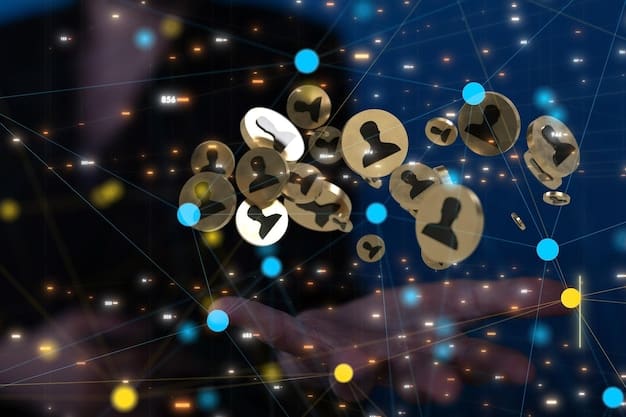Web3 News 2025: Personalized Feeds & Tokenized Data Impact

Web3 news is poised to revolutionize user experience by 2025 through personalized news feeds powered by tokenized data, offering greater control, relevance, and potential financial incentives.
The landscape of Web3 news is rapidly evolving, promising a future where personalized news feeds driven by tokenized data reshape the way we consume information by 2025.
The Rise of Web3 and Decentralized News
Web3 represents a paradigm shift in how we interact with the internet. Unlike Web2, which is dominated by centralized platforms, Web3 aims for decentralization, empowering users with greater control over their data and online experiences. This shift has significant implications for the future of news consumption.
Decentralized news platforms are emerging as alternatives to traditional media outlets. These platforms leverage blockchain technology to ensure transparency, immutability, and resistance to censorship. By distributing news creation and curation across a network of participants, they aim to foster a more democratic and trustworthy information ecosystem.
Key Features of Decentralized News Platforms
Decentralized news platforms offer several key features that differentiate them from their Web2 counterparts:
- Transparency: All transactions and content are recorded on a public blockchain, ensuring accountability and preventing manipulation.
- Censorship Resistance: The decentralized nature of the network makes it difficult for any single entity to control or censor content.
- User Empowerment: Users have greater control over their data and can participate in the curation and governance of the platform.
The transition to Web3 news models is not without its challenges. Scalability, user experience, and regulatory uncertainty remain significant hurdles. However, the potential benefits of a more decentralized, transparent, and user-centric news ecosystem are driving innovation and adoption.

In conclusion, the rise of Web3 and decentralized news platforms presents a compelling vision for the future of information consumption. By leveraging blockchain technology and empowering users, these platforms have the potential to address many of the challenges facing the traditional media landscape.
Personalized News Feeds: Tailoring Information to the Individual
Personalized news feeds are not a new concept. Web2 platforms have long used algorithms to curate content based on user preferences and behavior. However, in the context of Web3, personalization takes on a new dimension, driven by user control and data ownership.
Web3 personalized news feeds utilize a variety of techniques to tailor information to the individual. These techniques include:
- Collaborative Filtering: Recommending content based on the preferences of similar users.
- Content-Based Filtering: Analyzing the characteristics of articles and matching them to user interests.
- Semantic Analysis: Understanding the meaning and context of articles to provide more relevant recommendations.
The Advantage of User-Controlled Data
One of the key advantages of Web3 personalized news feeds is that users have greater control over their data. They can choose what information to share, how it is used, and who has access to it. This level of control empowers users to shape their own information environment and avoid filter bubbles.
Furthermore, Web3 platforms often reward users for sharing their data. This incentivizes participation and contributes to the accuracy and effectiveness of personalization algorithms. By combining advanced personalization techniques with user-controlled data, Web3 news feeds can deliver a more relevant, engaging, and empowering experience.
In summary, personalized news feeds in Web3 offer a significant improvement over their Web2 counterparts. By prioritizing user control, data ownership, and advanced personalization techniques, these feeds can provide a more tailored and empowering information experience.
Tokenized Data: Incentivizing Participation and Accuracy
Tokenized data is a core component of the Web3 news ecosystem. By representing data as tokens on a blockchain, platforms can incentivize participation, reward accuracy, and create new economic models for news creation and curation.
Tokenized data can be used in a variety of ways within a Web3 news platform:
- Rewarding Content Creators: Tokens can be distributed to creators based on the quality and popularity of their content.
- Incentivizing Curation: Tokens can be awarded to users who accurately rate and categorize news articles.
- Facilitating Data Sharing: Tokens can be used to compensate users for sharing their data with personalization algorithms.
Ensuring Data Accuracy and Quality
One of the key challenges in the news industry is ensuring accuracy and combating misinformation. Tokenized data can play a crucial role in addressing this challenge. By incentivizing accuracy and penalizing the spread of false information, platforms can create a more trustworthy information environment.
For example, users who flag misinformation can be rewarded with tokens if their claims are verified. Conversely, users who spread false information can be penalized by losing tokens. This system of incentives and penalties can help to filter out inaccurate content and promote reliable news sources.

In conclusion, tokenized data is a powerful tool for incentivizing participation, rewarding accuracy, and creating new economic models for Web3 news. By leveraging the power of blockchain technology, platforms can create a more trustworthy, transparent, and user-centric information ecosystem.
The User Experience Revolution: Control, Relevance, and Rewards
The convergence of Web3, personalized news feeds, and tokenized data is poised to revolutionize the user experience by 2025. Users will have greater control over their data, access to more relevant information, and the opportunity to earn rewards for their participation.
This revolution will manifest in several key ways:
- Increased Control: Users will have granular control over their data and how it is used to personalize their news feeds.
- Improved Relevance: Personalization algorithms will be more accurate and effective, delivering more relevant and engaging content.
- Financial Incentives: Users will be able to earn tokens for creating, curating, and sharing accurate information.
Addressing the Challenges of Information Overload
In today’s information-saturated world, it can be challenging to find reliable and relevant news. Web3 personalized news feeds can help to address this challenge by filtering out noise and delivering only the information that is most important to the individual.
Furthermore, the tokenized data model can incentivize users to focus on quality over quantity. By rewarding accuracy and penalizing misinformation, platforms can promote a more thoughtful and informed approach to news consumption.
In summary, the user experience revolution driven by Web3 news will empower users with greater control, access to more relevant information, and the opportunity to earn rewards for their participation. This will lead to a more engaging, informed, and empowered user base.
Challenges and Opportunities in the Web3 News Landscape
While the potential benefits of Web3 news are significant, there are also several challenges that need to be addressed. These challenges include:
- Scalability: Blockchain technology can be slow and expensive, making it difficult to scale Web3 news platforms.
- User Experience: Web3 interfaces can be complex and confusing for mainstream users.
- Regulatory Uncertainty: The regulatory landscape for Web3 technologies is still evolving, creating uncertainty for news platforms.
The Path to Mainstream Adoption
Despite these challenges, there are reasons to be optimistic about the future of Web3 news. As blockchain technology matures and user interfaces become more user-friendly, adoption rates are likely to increase. Furthermore, as regulatory clarity emerges, more established news organizations may begin to explore Web3 models.
For example, innovative solutions like Layer-2 scaling solutions can increase the throughput of blockchain networks, making them more suitable for high-volume applications like news distribution. Simple and intuitive user interfaces can make Web3 platforms accessible to a wider audience. And clear regulatory frameworks can provide the certainty that businesses need to invest in Web3 technologies.
In conclusion, while there are challenges to overcome, the opportunities in the Web3 news landscape are vast. By addressing these challenges and focusing on user experience, scalability, and regulatory compliance, Web3 news platforms can pave the way for a more democratic, transparent, and user-centric information ecosystem.
Predictions for Web3 News in 2025 and Beyond
Looking ahead to 2025 and beyond, several trends are likely to shape the Web3 news landscape:
- Increased Personalization: AI-powered personalization algorithms will become even more sophisticated, delivering highly tailored news experiences.
- Expansion of Tokenized Data Models: Tokenized data will be used in more creative ways to incentivize participation, reward accuracy, and create new economic models.
- Integration with Other Web3 Applications: Web3 news platforms will increasingly integrate with other Web3 applications, such as decentralized social media and metaverse experiences.
The Future of News Consumption
The convergence of these trends will likely lead to a future where news consumption is more personalized, engaging, and rewarding. Users will have greater control over their information environment, access to more relevant content, and the opportunity to earn rewards for their participation.
Moreover, the democratization of news creation and curation will likely lead to a more diverse and inclusive information ecosystem. By empowering individuals to share their perspectives and contribute to the news narrative, Web3 can help to create a more informed and engaged citizenry.
In summary, the future of Web3 news is bright. By embracing innovation, prioritizing user empowerment, and addressing the challenges of scalability and regulation, Web3 news platforms can pave the way for a more democratic, transparent, and user-centric information ecosystem.
| Key Point | Brief Description |
|---|---|
| 🌐 Decentralization | Web3 news shifts from centralized platforms to decentralized networks. |
| 🔑 User Control | Users gain control over their data and personalize news feeds. |
| 💰 Tokenization | Data is tokenized, incentivizing participation and accuracy. |
| 🤖 AI-Powered Personalization | AI algorithms enhance news feed personalization with refined accuracy. |
Frequently Asked Questions
▼
Web3 news refers to news platforms that operate on a decentralized network, leveraging blockchain technology to ensure transparency, immutability, and user empowerment. It contrasts with traditional, centralized news outlets.
▼
Tokenized data represents data as tokens on a blockchain. These tokens can be used to incentivize content creation, curation, data sharing, and accuracy verification within the Web3 news ecosystem.
▼
Personalized news feeds in Web3 offer users greater control over their data, access to more relevant information, and the opportunity to earn rewards for their participation. They also help address information overload.
▼
Web3 news faces challenges related to scalability, user experience, and regulatory uncertainty. Blockchain technology can be slow and complex, and the regulatory landscape is still evolving.
▼
By 2025, Web3 news is expected to feature increased personalization driven by AI, expansion of tokenized data models for incentivization, and integration with other Web3 applications like decentralized social media.
Conclusion
In conclusion, the convergence of Web3, personalized news feeds, and tokenized data holds immense promise for transforming the way we consume information. While challenges remain, the potential for a more democratic, transparent, and user-centric news ecosystem is driving innovation and paving the way for a future where users are empowered to take control of their information environment.





